#grassland amphibians
Explore tagged Tumblr posts
Text
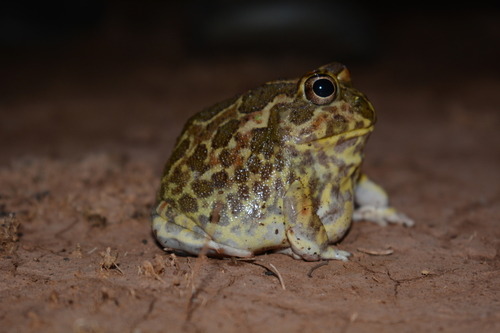
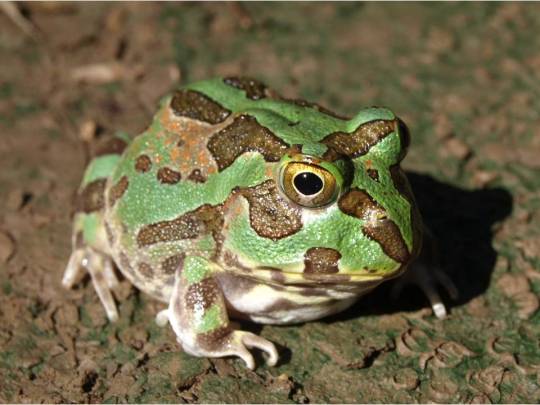
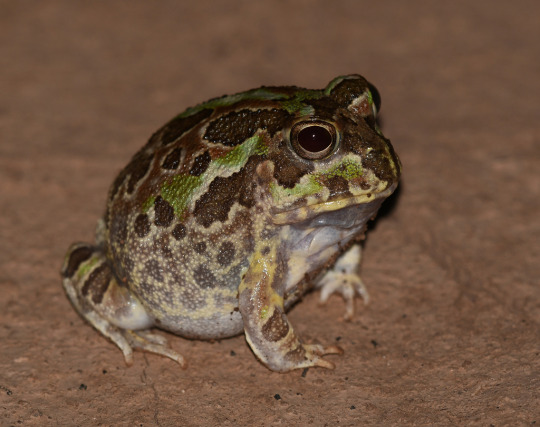
Chatting with the Chaco Horned Frog
The Chacao horned frog, also known as the lesser Chini frog (Chacophrys pierotti) is a species of horned frog found in central South America, from northern Argentina to Paraguay and Bolivia. It resides in an area known as the Gran Chaco or Dry Chaco, named for its high temperatures and lack of rainfall. Within this region, the Chaco horned frog resides mainly in dry scrubland, floodplains, and dry tropical forests.
Due to the extreme environment in which they live, lesser Chini frogs spend most of the year underground. During the cool, dry season from May to September, adults dug burrows and hibernate; to keep themselves moist, they surround themselves in a cocoon of dead skin. Once the rainy season begins in October, they emerge to feed and breed. Like most frogs, the diet of C. pierotti consists mainly of insects; particularly beetles, ants, bees, butterflies, and moths, and occasionally smaller frogs or tadpoles. There is no record of predators targeting this species, though their small size likely makes them an easy target for foxes, coyotes, and opossums.
At only 4.5 - 6.5 cm (1.7 - 2.5 in) long, lesser Chini frogs are on the small side. However, they generally appear rather plump and round-- the better to retain moisture during the dry season. Adults can appear mottled brown or green, which helps them to camouflage against the surrounding foliage. Despite their name, Chaco horned frogs have no horns or similar-looking appendages.
Mating occurs throughout the rainy season, and typically peaks in January. Males attract females by calling, especially just after heavy rains. Females lay their eggs in the rivers and temporary lagoons that form, and the larvae hatch some time later. Tadpoles only take about 2 weeks to metamorphose into adults, and by the following rainy season they are ready to mate. Individuals typically only live to be about 5 years in the wild.
Conservation status: The IUCN has classed C. pierotti as Least Concern. However, it is threatened by habitat loss due to agriculture and deforestation, and by collection for the pet trade.
Photos
Nadia Bach
Norman Scott
Josh Vandermeulen
#chacao horned frog#Anura#Ceratophryidae#common horned frogs#frogs#amphibians#grasslands#grassland amphibians#tropical forests#tropical forest amphibians#south america#central south america
89 notes
·
View notes
Text
"A tribal-led nonprofit is creating a network of native bison ranchers that are restoring ecosystems on the Great Plains, restoring native ranchers’ connections with their ancestral land, and restoring the native diet that their ancestors relied on.
Called the Tanka Fund, they coordinate donors and partners to help ranchers secure grazing land access, funds needed to install and repair fencing, increase their herd sizes, and access markets for bison meat across the country.
That’s the human part of the story. But as Dawn Sherman, executive director of the Tanka Fund, told Native Sun News, they’re “buffalo people” and these four-legged, 2,000 lbs. “cousins” are equal-part-protagonists.
The return of the bison means the return of the prairie, one of the three great grassland ecosystems on the planet, of which just 1% remains as it was when the Mayflower arrived.
“Bringing buffalo back to their ancestral homelands is essential to restoring the ecosystem. We know that the buffalo is a keystone species,” said Dawn Sherman, a member of the Lakota, Delaware, Shawnee, and Cree.
“Bringing the buffalo back to the land and to our people, helps restore the ecosystem and everything it supports from the animals to the plants to the people. It’s come full circle. That’s how we see it.”
As Sherman and the Tanka Fund help native ranchers grow their operations, everyone is well aware of the power of the bison to transform the environment: just as nations across Europe are, who are reintroducing wood bison to various ecosystems, for all the same reasons.
Sherman points out the variety of ways in which buffalo anchor the prairie ecosystem. The almost-extinct black-footed ferret, she points out, lived symbiotically with the bison, and with the latter gone, the former followed—nearly.
The long-billed curlew uses bison dung as a disguise to hide nests from predators. Deer, pronghorn antelope, and elk all rely on bison to plow through deep snows and uncover the grasses that these smaller animals can’t reach.
Everywhere the bison hurls its massive body, life springs in the beast’s wake. When bison roll about on the plains, it creates depressions known as wallows. These fill with rainwater and create enormous puddles where amphibians and insects thrive and reproduce. Certain plants evolved to grow in the wet conditions of the wallows which Native Americans harvested for food and medicine.
Native plants evolved under the trampling hooves of millions of bison, and that constant tamping down of the Earth is a key necessity in the spreading of native wildflower seed.
Indeed, Sherman says some of these native ranchers are bringing bison onto lands still visibly affected by the Dust Bowl, and already the animals are acting like a giant wooly cure-all for the land’s ills.
Since 2020, the Tanka Fund, in partnership with the Inter-Tribal Buffalo Council and the Nature Conservancy, has overseen the transfer of 2,300 bison from Nature Conservancy reserves to lands managed by ranchers within the Tanka Fund network.
“[T]he more animals that we can get the more of that prairie we can restore,” said Sherman. “We can help restore the land that has been plowed and has been leased out to cattle ranchers.”"
youtube
-Article via Good News Network, February 13, 2025. Video via Tanka Fund, July 17, 2024.
#indigenous#indigenous peoples#first nations#native americans#bison#ecology#ecosystem#ecosystem restoration#keystone species#endangered species#environment#prairie#great plains#land back#good news#hope#Youtube
11K notes
·
View notes
Note
Hi! I am absolutely enamored with your blog 🫶 could I make a request for endangered/near extinct reptiles or amphibians?
Thank you so much booboo, here are some endangered herps for your enjoyment...

Gharial (Gavialis gangeticus), female, family Gavialidae, National Chambal Sanctuary, India
CRITICALLY ENDANGERED.
photograph by Clpramod

Cochin Forest Cane Turtle (Vijayachelys silvatica), family Geoemydidae, from the Western Ghats of India
ENDANGERED.
photograph by Davidvraju

Earless Monitor Lizard (Lanthanotus borneensis), family Lanthanotidae, endemic to Borneo
ENDANGERED.
Semi-aquatic.
Closely related to the true monitor lizard in the family Varanidae.
The only member of its family.
They do have inner ears, and are capable of hearing, despite the lack of ear openings and tympana.
photograph by Chien C. Lee

San Francisco Garter Snake (Thamnophis sirtalis tetrataenia), family Colubridae, coastal California, USA
ENDANGERED.
Photograph by Garter Kings


Northern Corroboree Frog (Pseudophryne pengilleyi), family Myobtrachidae, found in SE Australia
CRITICALLY ENDANGERED.
Poisonous.
Though it’s found in SE Australia, it is the more northerly species of the 2 Corroboree Frogs.
Found in wet grasslands, and surrounding moist forest habitats.
Endangered due to the Chytrid fungus, climate change, introduced species, and habitat degradation due to cattle grazing.
photographs by Damien Esquerré and Michael Swan


Central Asian Salamander (Ranodon sibiricus), family Hynobiidae, found in streams in Kazakhstan and NW China.
ENDANGERED.
photograph by Henk Wallays
390 notes
·
View notes
Text
you have everything you need to survive and you will get through the trip and come home safely
for the purposes of "polls can only have ten things", your options are limited to land ecosystems
2K notes
·
View notes
Text
Happy Earth Day!

We share this beautiful planet with over two million other species, from wasps the size of a grain of dust to whales larger than an office building. Yet, many of these species now face extinction due to the ways in which we humans have modified the planet to suit our needs. According to the International Union for the Conservation of Nature (IUCN), 13% of birds, 21% of reptiles, 27% of mammals, 37% of sharks, and 41% of amphibians are currently endangered, and some estimates suggest that 28% of all species on Earth are at risk of extinction in the near future. Imagine you woke up tomorrow and more than a quarter of every plant, animal, and fungus, from the elephants at the zoo to the earthworms beneath the soil, simply vanished, never to be seen ever again. If we choose to continue treating our planet so poorly, this will become a reality.
Here at Consider Nature, we believe the best way to protect our planet is to arm ourselves with knowledge! Over the years, we have written many articles on some of Earth’s coolest, weirdest, and most-endangered species, in the hope of inspiring readers to step up to the plate and protect biodiversity. I hope you will spend a few minutes of your Earth Day today reading about some of the species we believe are worth saving.
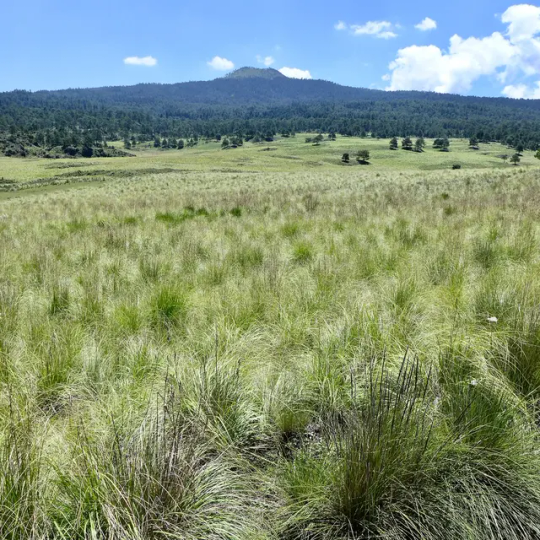
Zacaton grasslands in central Mexico, home to the Zacatuche, or volcano rabbit. Image credit: Jurgen Hoth
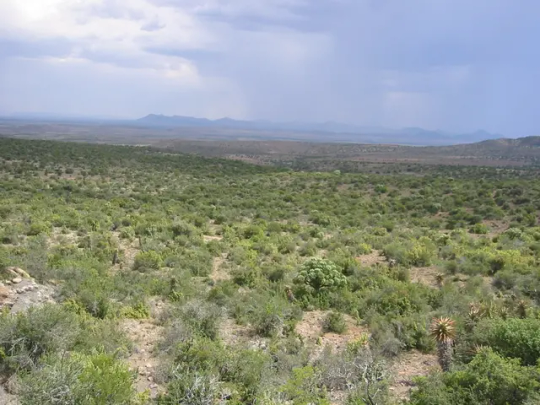
The Succulent Karoo, one of the most biodiverse ecosystems on Earth and home to the Karoo Padloper. Image credit: Tjeerd Wiersma under CC BY-SA 2.0.

The Gulf of California, home of the critically endangered Vaquita. Image credit: Natural World Heritage Sites.
660 notes
·
View notes
Text


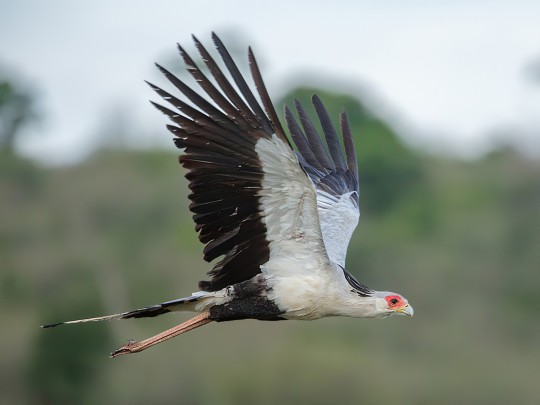
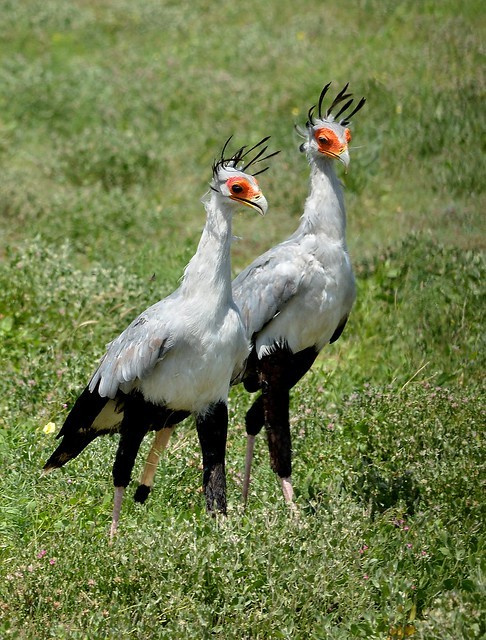
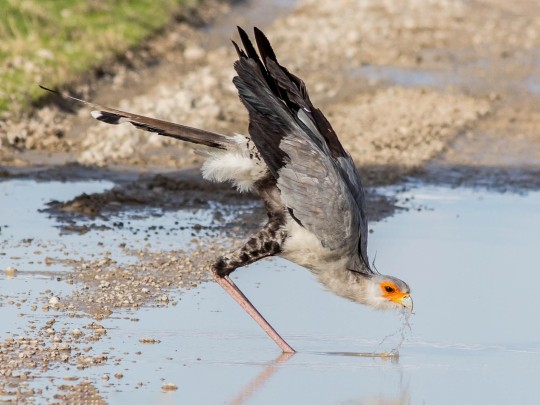
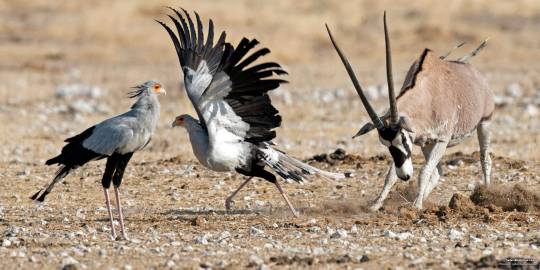

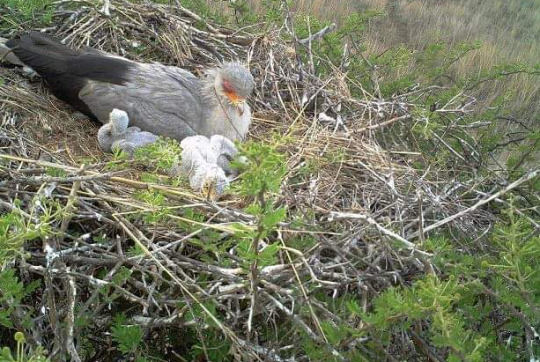


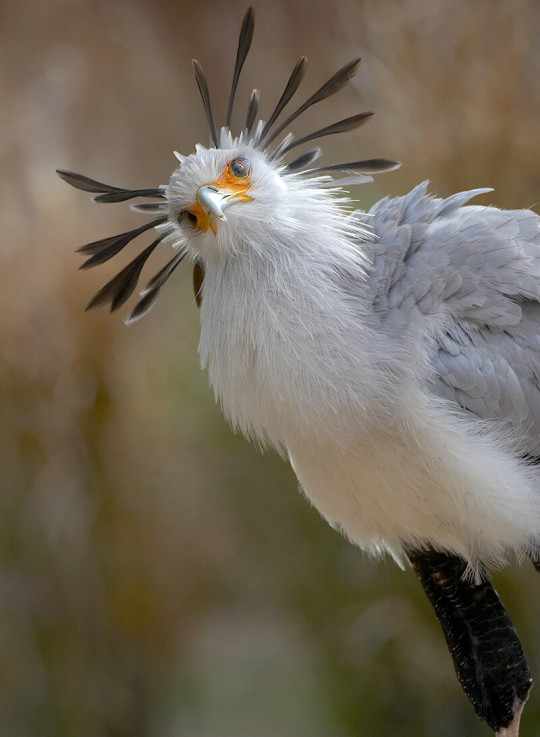
The secretarybird or secretary bird is a species of is a large, mostly terrestrial, bird of prey which is endemic to sub-saharan Africa. The secretarybird prefers to inhabit open grasslands, savannas, shrublands, and highlands rather than rainforests, swamps, and woodlands. In these habitats Secretarybirds will form monogamous pairs and defend a large territory of around 19 square miles ( 50 km2), and while capable of flight secretary birds are a primarily terrestrial animal. Hunting in pairs or with there offspring they stalk through there habitat in long careful strides in search of prey such as large invertebrates, lizards, amphibians, small turtles and tortoises, hares, hedgehogs, rodents, polecats, small felines, young gazelle, mongoose, birds up to the size of guinea fowl, and especially snakes. Once found a secretarybird will chase after prey with the wings spread and kill by striking with swift blows of the feet. Standing around 4.3ft (1.3m) tall, 3.7 to 4.11ft (1.1 to 1.5m) in body length, with a 6.3 to 6.11ft (1.9 to 2.1m) wingspan. The secretarybird is a large instantly recognizable bird with an eagle-like body on crane-like legs, featherless red-orange face and predominantly grey plumage, with a flattened dark crest and black flight feathers and thighs.Breeding may occur year round and during courtship, they exhibit a nuptial display by soaring high with undulating flight patterns and calling with guttural croaking. Males and females can also perform a ground display by chasing each other with their wings up and back. Both sexes build a relatively flat 3 to 5ft (1 to 1.5m) wide platform nest out of sticks and grasses at the top of a dense thorny tree, some 8 to 40ft (2.5 to 13m) above the ground. Here 1 to 3 chalky blueish whiteish green eggs are laid and incubated for 45 days until hatching. The young remain with there parents until becoming independent at some 4 to 7 months of age. Under ideal conditions a secretarybird may live upwards of 15 years.
#pleistocene pride#pleistocene#pliestocene pride#pliestocene#cenozoic#ice age#stone age#dinosaur#bird#secretarybird#secretary#secretary bird
163 notes
·
View notes
Text
Thinking about Eliksni diet again...thinking about how their teeth are needle-sharp and serrated on the edges so they're perfect for both grabbing slippery prey and shearing off chunks of flesh from larger animals...thinking about how the layout of their jaws means that a bite would have an animal pinned in place with their inner set of teeth while their mandibles and upper teeth would cut through meat like a pair of scissors...and yet we know that they like fruit, will eat vegetables, and apparently have baked goods, like bread. What that implies to me is that they're primarily carnivores that suppliment their diet with fruit, but that they'll also dine on anything that has a suitibly flesh-like texture, since Misraaks has canonically cooked eggplant and that's kinda fleshy.
Which in turn makes me wonder how they prepare their dishes and what sort of culinary cultures each of the House would have had, what sort of food discourse would have popped up, etc. Were there some Eliksni who believed the healthiest option was to eat prey whole? Some who'd eat live prey? Was their discourse around what the most suitible method of dispatch was, or if raw vs cooked meats was better? Bc I can imagine that animals that can be eaten whole/in one bite would be seen as more permissable to eat live (like bugs, amphibians, small fish) bc death would be swift, but obviously Houses that farmed large livestock (like the Dancers, maybe, whom I headcanon to have lived in the grasslands and have had large herd animals) would probably be appaled at the thought of such a thing, no matter how other houses raved at it making the taste better.
As for eating raw meat, parasites with sutibly farmed livestock wouldn't be an issue, so I imagine that eating food raw was more of a regional thing than not: raw meats were more often common in colder climates than hotter ones, with the exception of desert-dwelling Eliksni, who would typically eat small prey raw and fresh to preserve as much water content as possible, and cooked/dried meats when they were larger animals. Cooking is a measure of preservation as much as it is means of easing digestion, so hotter climates would have had to cook more just to prevent their catches to go to waste, while those in colder climes didn't have to worry as much about their meats spoiling when doing food prep
I also imagine that, for the most part of their history, the meats consumed were probably aquatic in nature- fish and invertebrates, amphibians and their larvae, etc etc. Larger herd animals were probably rare hunting treats until their domestication, and were still rarer than amphibians and invertebrates because of their longer lifespans/slower breeding cycles
38 notes
·
View notes
Text

Two popular classics! But who is the Superb Owl?
The most widely distributed owl in the Americas, the great horned owl ranges throughout North America and much of Central and South America. They can be found in almost any habitat. These owls mostly prey on rodents and lagomorphs, but are opportunistic hunters and will take anything they can catch, including smaller owls. They hunt by watching from a perch. Regarding their ecological niche, they are sometimes described as the nocturnal equivalent of red-tailed hawks. Great horned owls nest earlier in the year than most other raptors. These owls are very long-lived, with a typical lifespan of around 13 years in the wild (with a record of 28) and up to 50 in captivity!
Western barn owls live throughout Europe as well as much of Africa and the Arabian peninsula in a wide variety of habitats, but most especially favoring open woodland and grasslands. These owls mostly eat small mammals such as rodents and shrews, but will also eat birds, amphibians, lizards, and insects. They hunt by flying slowly over ground and pouncing when movement is detected. Western barn owls are usually monogamous, mating for life. After fledging, young remain with their parents for only about a month. Since barn owls have relatively high metabolic rates, they eat proportionally more rodents than other owls and are thereby appreciated by farmers as effective pest control.
511 notes
·
View notes
Note
Do you have any pointers on figuring out speculative island evolution? I have an island in middle of a massive lake & I'm trying to fill it with wildlife that would "make sense". The climate is rather cold & the one species I'm certain on so far is a kind of "dwarf mammoth" but obviously there would be more species then just them.
for starters, here's an article about island dwarfism and gigantism! the gist of it is that in an insular environment such as an island, animals which are normally large get quite small, and animals which are normally small tend to get bigger, just like your dwarf mammoth idea.
as for general island ecology, you're going to have a lot of aquatic animals, as well as flying ones! it being in the middle of a lake makes it less likely to have very many land animals, since they would have had to arrive in a time when it was easier to cross the area that is now a giant lake, but you can certainly have a few, like the mammoths.
I would suggest looking at things like river otters, lake Baikal seals, various waterfowl, and freshwater fish and shellfish! there could also be some species of amphibian, though they're likely in hibernation during the cold months. still, it's not impossible to have amphibians and reptiles in a cold region! wood frogs, for example, are able to hibernate by allowing their whole bodies to freeze in the cold.
here are some important niches to consider:
herbivores, perhaps with the larger ones more focused on trees for food while smaller herbivores consume plants on the ground
rodents, eating and storing seeds and nuts
predators, keeping the herbivore populations reasonably sized
scavengers and opportunistic omnivores
insects and decomposers
pollinators
fish, clams, and other aquatic animals like freshwater seals or otters
migrating birds and waterfowl, as well as predatory birds and smaller birds that eat seeds and insects
water plants!
also consider how the plants got here. are their seeds brought in via the feces of migrating birds? are there plants that reproduce by scattering their seeds in the wind? what's the situation with fruiting plants? etc. an environment can only have animals it is able to sustain nutritionally. grass grazing animals that prefer wide open spaces would have a rough time in a dense forest, and animals reliant on trees would suffer in a wide grassland. how big is your island? what population sizes can it sustain in every niche? every animal and plant available will have an effect on the population sizes of the other species present! as the number of herbivores rises, so too will the numbers of their predators! and if one population drops, so will the others around them.
21 notes
·
View notes
Text
A writer’s guide to forests: from the poles to the tropics, part 7
Is it no.7 already? Wow. A big shout out to everyone who has had the patients to stick with this. Now onto this week’s forest…
Dry forest
Water is life. That’s a fact. And especially where it doesn’t rain for more than half the year.
Location: Dry forests are scattered throughout the Yucatán peninsula ,South America, various Pacific islands,Australia, Madagascar, and India. Areas have been cleared by human activity, and the SA dry forests are classified as the most threatened tropical forests.
Climate: Temperate to tropical, with just enough rain to sustain trees. Many are monsoonal, with rain coming in one or two brief periods separated by a long dry season.
Plant life- Hardy trees, such as Baobab and Eucalyptus are able to last with little rain by tapping into groundwater with extensive root systems. Many trees are evergreen, but in India, many species are deciduous. Trees are often more spaced out, and shrubs and grasses grow extensively. Cacti are common plants in the Americas, with some growing tall enough to be considered trees. In order to survive the heat and lack of water, many small plants are annuals, or store water in tubers. Palms can make up a large percentage of the trees, as was the case in the now vanished forests of Easter Island.
Animal life- As they can come and go when they please, birds are common species. Larger animals are active year round, with smaller species of mammals, amphibians, and certain insects only coming out during the rainy season. Isolation means that islands become home to many endemic species; think about Madagascar and the lemurs, or Darwin’s finches, iguanas, and tortoises in the Galapagos. Isolation has also led to the marsupials of Australia developing to fill the niches that would normally be occupied by placental mammals .The introduction of invasive species has brought about the extinction of island fauna.
How the forest affects the story- Water, or the lack of will be the biggest challenge your characters will face. Rivers and lakes may be seasonal, so other sources will have to be utilized. Drinkable fluids can be obtained from various plants and animals, or maybe the bedrock is porous and water accumulates in cenotes. Your characters could come from a culture that builds artificial reservoirs to collect the rain and store it for the dry season. With careful water management, cities can thrive in dry areas. But your characters will have to be careful. Prolonged drought will see societies go the way of the Maya. Deforestation leaves the topsoil vulnerable to the wind, and forests, farms, and grassland will inevitably turn to desert. Whether nomadic or sedentary, your characters and their society will have to find a way to interact with the forest without destroying it or themselves. Can they do it? Can a damaged biosphere be restored before it’s too late? The success or failure of your characters and/or their predecessors can be a driving focus of the plot. Of course ,when the rains do come, it could be in the form of a cyclone. Dry ground does not readily absorb water, and flash floods are a danger. Water can grant life, but it can take it as well.
#writing#creative writing#writing guide#writing inspiration#writing prompts#writer#writers#writing community#writer on tumblr#writeblr
48 notes
·
View notes
Text
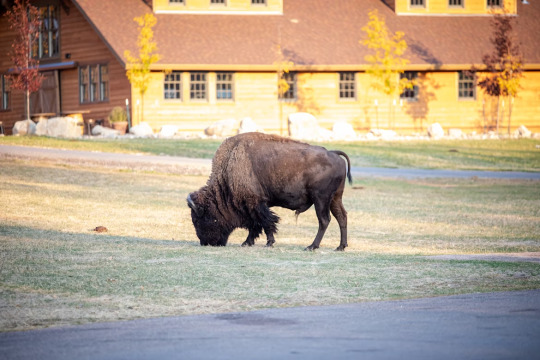
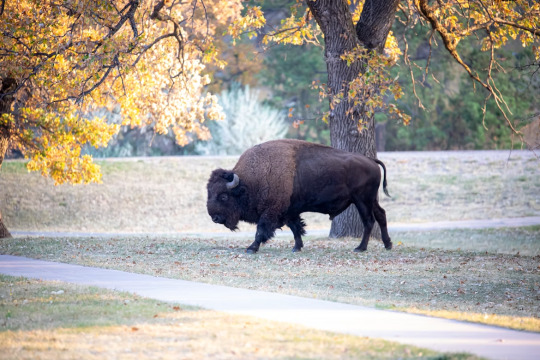
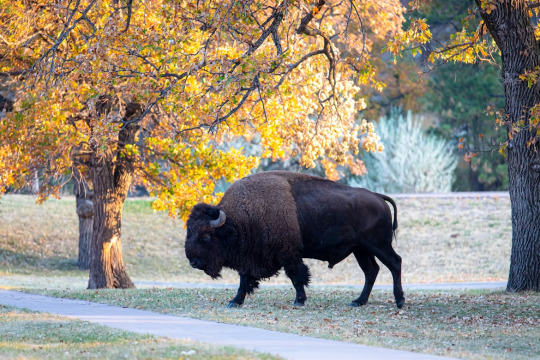
Plains Bison in Custer, South Dakota, USA
Stephanie LeBlanc
The Plains bison is one of two subspecies/ecotypes of the American bison, the other being the wood bison.
Status: Near Threatened
Population: 45,000
Scientific Name: Bison bison bison
Kingdom: Animalia
Phylum: Chordata
Subphylum: Vertebrata
Class: Mammalia
Order: Artiodactyla
Family: Bovidae
Subfmaily: Bovinae
Tribe: Bovini
Genus: Bison
Weight: 701 to 2,000 pounds
Length: 7-12 ft.
Habitat: Grassland
Range: Bison once roamed from Florida to Washington, Canada, and Mexico - The entire U.S.
Predators: Wolves are the primary predator of bison across the continent. Local knowledge also indicates that bears play a role in predation.
Diet: Bison are considered generalist foragers, meaning they eat a wide array of herbaceous grasses and sedges commonly found in mixed-grassed prairies. These types of plants include species such as Blue gramma, sand dropseed, and little bluestem.
Lifespan: The average lifespan for a bison is 10–20 years, but some live to be older. Cows begin breeding at the age of two and only have one baby at a time. For males, the prime breeding age is six to 10 years.
Importance: Bison graze the grasses at different heights, providing nesting grounds for birds. They also roll around and pack down the soil in depressions in the ground known as wallows. Their wallows fill with rainwater and offer breeding pools for amphibians and sources of drinking water for wildlife across the landscape.
#Custer#South Dakota#USA#Plains Bison#Bison#Wildlife#SDWildlife#US#United States#United States of America#North America
37 notes
·
View notes
Photo



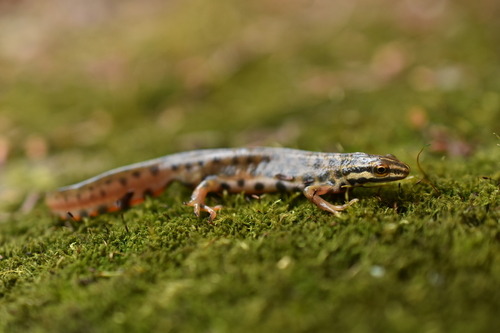
The Smooth Newt with the Smooth Moves
Also known as the European newt, northern smooth newt, or common newt (Lissotriton vulgaris), the smooth newt is one of the most common species in Europe and western Asia. It is also the only newt species found in Ireland. There are currently three recognised subspecies distributed throughout this range, and four others have been reclassified as distinct species. The common newt is able to survive in a variety of habitats, including deciduous and coniferous forests, wetlands, meadows, parks, and gardens. Their only requirements are sufficient sunlight and water with sufficient vegetation.
Like most newts, the northern smooth newt spends the majority of its time foraging for food on land. Their diet is carnivorous, consisting of insects, worms, snails, slugs, and larvae. When available, L. vulgaris may also eat the eggs of its own species. In turn, many animals prey on the European newt, including waterbirds, snakes, frogs, and larger newts. To avoid these predators the smooth newt is active mainly at night, and will secrete a toxic mucus when threatened. While active, they are largely solitary but from October to March several individuals will hibernate together under logs or leaf litter burrows.
Almost as soon as the common newt emerges from hibernation, they begin migration to their breeding sites-- usually the ponds in which they spawned. Males undergo a dramatic transformation, growing large crests and becoming brightly colored. When a female enters the water, the male swims around her and sniffs her cloaca. He then vibrates his tail to fan his pheromones towards her. Finally, he will swim away and, if the female is interested, she will follow him. He then deposits a packet of sperm, or spermatophore, that the female picks up for fertilization. Rival males may try to lead the female towards their own spermatophores, and clutches of eggs often have multiple fathers.
Females deposit anywhere from 100 to 500 eggs, each of which is carefully wrapped in aquatic vegetation. Larvae hatch after only 20 days, and quickly begin developing. Unlike frogs and toads, newt larvae have external, feathery gills, and develop their front legs first. After about three months, the larvae absorb their gills and leave the water as newtlets or efts. However, when temperatures are particularly low and aquatic prey is abundant, some adults retain their gills and stay aquatic in a phenomenon known as paedomorphism. These adults are fully capable of sexual reproduction, and when moved to areas with a larger population will often metamorphose into terrestrial adults.
Adult smooth newts are rather small, reaching only 9–11 cm (3.5–4.3 in) and 0.3–5.2 g (0.011–0.183 oz). Males are slightly larger than females. The head and back are dark brown or olive, while the underside is much lighter. Both males and females have dark spots on their bellies, and males also sport a bright orange stripe. In the spring, the colors in males become more vivid and the spots grow larger. Males also develop a large yellow crest that runs from the head to the table, and is dotted with dark bands.
Conservation status: The IUCN has designated the European newt as Least Concern, as it is common over most of its range. Threats include habitat destruction and the introduction of invasive fish species.
If you like what I do, consider leaving a tip or buying me a ko-fi!
Photos
Philip Precey
Derek Middleton
Christoph Moning via iNaturalist
Kristýna Coufalová via iNaturalist
#common newt#smooth newt#Urodela#Salamandridae#newts#salamanders#amphibians#deciduous forests#deciduous forest amphibians#evergreen forests#evergreen forest amphibians#grassland birds#grassland amphibians#wetlands#wetland amphibians#urban fauna#urban amphibians#europe#asia#west asia#animal facts#biology#zoology
149 notes
·
View notes
Text
FrogToadber 2024
are you a fan of amphibians? do you like making art? this October, follow along with FrogToadber's prompt list! this is open to all forms of art, not just drawing. use the tag #frogtoadber2024 to have your art featured on the blog! image descriptions and/or alt text are strongly encouraged. prompts under the cut:
American Bullfrog
Axolotl
Rivers
Eastern Tiger Salamander
Tomato Frog
Plains Toad
Forest
Poison Dart Frog (any color)
Lifecycle/Metamorphosis
Chinese Giant Salamander
Red-Eyed Tree Frog
Olm
Fire Belly Newt
Goliath Frog
Desert
Mossy Frog
Hellbender
Spadefoot Toad
An amphibian native to your region
Amphiuma
White’s Tree Frog
Wetlands
Caecilian
A prehistoric amphibian
Grasslands
Midwife toad
Desert Rain Frog
Crocodile Newt
Cave
Glass Frog
Your favorite amphibian
#frogtoadber2024#amphibians#inktober#frogs#toads#salamanders#newts#artists on tumblr#prompt lists#art prompts
7 notes
·
View notes
Text
Monster Hunter Wilds ‘1st Trailer,’ screenshots
From Gematsu
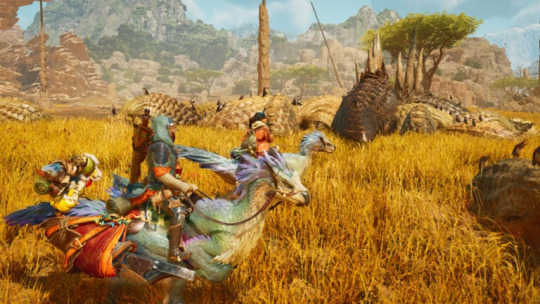
Capcom has released the first official trailer for Monster Hunter Wilds, which introduces the game’s untamed landscape teeming with new monsters, as well as first glimpses of the story, characters, system, and more.
Get the latest details below.
In Monster Hunter Wilds, players join the ranks of a special Research Commission team investigating the Forbidden Lands. Fully voiced for the first time in the Monster Hunter series, the hunter ventures into the unknown with their companions, including Guild-appointed handler Alma, their Palico partner, and a mysterious child. Monster Hunter Wilds features multi-dimensional biomes that can transform in unexpected ways. The first locale to be unveiled is the Windward Plains, a vast region encompassing harsh deserts, twisted rock formations, and swaying grasslands abound with life. These immersive ecosystems are populated with wildlife acclimated to their surroundings, including smaller monsters like Dalthydon, an herbivorous wyvern that migrates seasonally, and Ceratonoth, who rely on males to shield the herd from raging storms with well-developed dorsal horns that serve as lightning rods. Of course, large monsters also roam the Windward Plains, including Doshaguma. While massive and territorial, these fanged beasts are curiously sometimes sighted stalking the plains in aggressive packs. Meanwhile, the formidable amphibian Chatacabra uses its surroundings and adhesive saliva to become an even stronger adversary by armoring its body with natural materials like ore. To help hunters meet the challenges that await in Monster Hunter Wilds, the beloved gameplay of the series has evolved with an arsenal of new features. Players will experience a seamless flow from story sequences to gameplay without interruption. To traverse this world’s sprawling environments, the game introduces Seikrets, a new type of mount. These nimble creatures can guide their riders to destinations and allow hunters to perform actions on the go, such as sharpening weapons, gathering materials, and wielding the slinger. Hunters can also swap to a secondary weapon with their Seikret, empowering hunting parties to adapt to the changing conditions out in the field without returning to base. All 14 of the series’ iconic weapon types return in Monster Hunter Wilds and have now evolved to include new actions. Additionally, the game introduces brand-new systems, such as Focus Mode, giving hunters more precise control over aiming, guarding, and attacking monsters’ weak points. The new Hook Slinger also offers hunters additional abilities, including contextual actions and the power to collect items from a distance – even when mounted atop their Seikret. Monster Hunter Wilds players who link their Monster Hunter: World save data can receive special bonus items. This includes the Felyne Leather Set (Palico Armor) and Felyne Acorn Spade (Palico Weapon) for linking Monster Hunter: World base game save data, and Felyne Duffel Set (Palico Armor) and Felyne Trekker Peckaxe (Palico Weapon) for linking save data from the title’s massive expansion Monster Hunter World: Iceborne.
Monster Hunter Wilds is due out for PlayStation 5, Xbox Series, and PC via Steam in 2025.
Watch a new trailer below. View a new set of screenshots at the gallery.
1st Trailer
English
youtube
Japanese
youtube
12 notes
·
View notes
Text
youtube
Monster Hunter Wilds - 1st Trailer
youtube
Japanese version
Monster Hunter Wilds will launch for PlayStation 5, Xbox Series X|S, and PC via Steam in 2025.

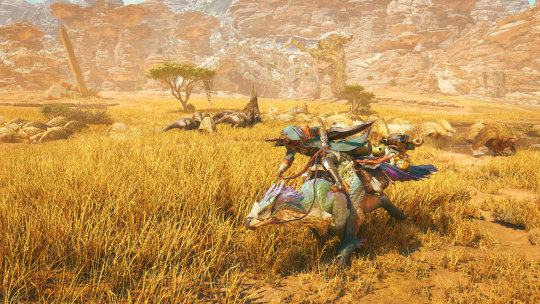

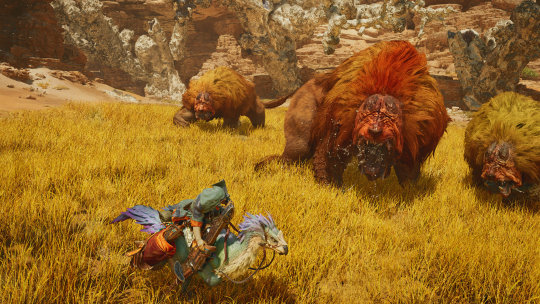











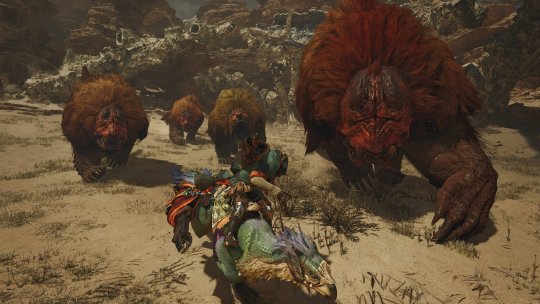














Screenshots
Latest details
In Monster Hunter Wilds, players join the ranks of a special Research Commission team investigating the Forbidden Lands. Fully voiced for the first time in the Monster Hunter series, the hunter ventures into the unknown with their companions, including Guild-appointed handler Alma, their Palico partner, and a mysterious child. Monster Hunter Wilds features multi-dimensional biomes that can transform in unexpected ways. The first locale to be unveiled is the Windward Plains, a vast region encompassing harsh deserts, twisted rock formations, and swaying grasslands abound with life. These immersive ecosystems are populated with wildlife acclimated to their surroundings, including smaller monsters like Dalthydon, an herbivorous wyvern that migrates seasonally, and Ceratonoth, who rely on males to shield the herd from raging storms with well-developed dorsal horns that serve as lightning rods. Of course, large monsters also roam the Windward Plains, including Doshaguma. While massive and territorial, these fanged beasts are curiously sometimes sighted stalking the plains in aggressive packs. Meanwhile, the formidable amphibian Chatacabra uses its surroundings and adhesive saliva to become an even stronger adversary by armoring its body with natural materials like ore.
To help hunters meet the challenges that await in Monster Hunter Wilds, the beloved gameplay of the series has evolved with an arsenal of new features. Players will experience a seamless flow from story sequences to gameplay without interruption. To traverse this world’s sprawling environments, the game introduces Seikrets, a new type of mount. These nimble creatures can guide their riders to destinations and allow hunters to perform actions on the go, such as sharpening weapons, gathering materials, and wielding the slinger. Hunters can also swap to a secondary weapon with their Seikret, empowering hunting parties to adapt to the changing conditions out in the field without returning to base. All 14 of the series’ iconic weapon types return in Monster Hunter Wilds and have now evolved to include new actions. Additionally, the game introduces brand-new systems, such as Focus Mode, giving hunters more precise control over aiming, guarding, and attacking monsters’ weak points. The new Hook Slinger also offers hunters additional abilities, including contextual actions and the power to collect items from a distance – even when mounted atop their Seikret. Monster Hunter Wilds players who link their Monster Hunter: World save data can receive special bonus items. This includes the Felyne Leather Set (Palico Armor) and Felyne Acorn Spade (Palico Weapon) for linking Monster Hunter: World base game save data, and Felyne Duffel Set (Palico Armor) and Felyne Trekker Peckaxe (Palico Weapon) for linking save data from the title’s massive expansion Monster Hunter World: Iceborne.
#Monster Hunter Wilds#MH Wilds#Monster Hunter#MonHun#Capcom#video game#PS5#Xbox Series#Xbox Series X#Xbox Series S#PC#Steam#State of Play#State of Play May 2024#long post
17 notes
·
View notes
Text
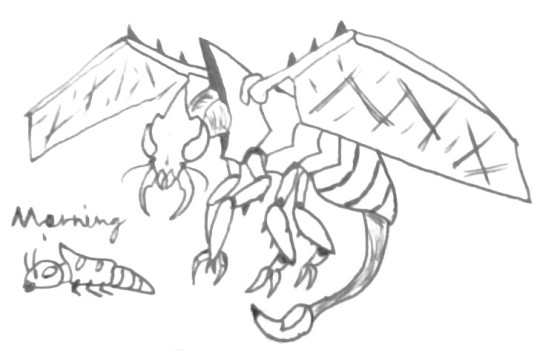
Another neopteran, this time based on potter wasps - WYRADIAL Title - Frigid insect Monster class - Neopteran Known locales - Deserts and savannah Element/ailment - Mucus + Ice Elemental weakness - Fire (3), Water (2), Thunder (1), Ice (1), Dragon (0) Ailment weakness - Poison (3), Paralysis (3), Blast (2), Stun (1), Sleep (0) Wyradial is a neopteran that inhabits desert regions, usually nesting close to grassland or oases. It is distinguished by its wasp-like appearance, with long sharp wings and a flexible stinger, and the dashing blue-and-yellow colouring of its exoskeleton. Its limbs are well-suited for handling debris, useful for building its caches, whilst the cutting mandibles hide a gland that excretes a thick mucus at surprising pressure. Wyradial's offspring are called Neoradials. In their larval state, they are mellow and slow in comparison to the high-octane adult. Lacking the developed features and ailments of Wyradial, Neoradials defend themselves by spitting a strong silk, encasing attackers in webbing to buy themselves time to dig to safety. An omnivore, there is nothing Wyradial won't gather in its single-minded pursuit of preparing for the future. Carrion, fruit, plants, tubers, fungi, bone, minerals - anything edible is collected by the neopteran and stored in the large caches it creates out of rock, mud and wood. Small burrows close to the cache host Wyradial's offspring, the Neoradials. These caches are vital for the neopteran and its brood to survive harsh dry seasons, and Wyradial will viciously defend them. Field workers are advised to steer clear of the cache; Wyradial will not hesitate to attack what it perceives to be a potential thief. Only when the neopteran is out foraging is it relatively docile, if only because it is too occupied with its work to bother with humans. The strong mucus Wyradial uses to craft its structures is also an effective defensive weapon, spat out onto foes to slow their movements and potentially let objects in the environment stick to them. If this fails, the neopteran brings its flexible stinger to bear and launches an icy residue. This can either be hardened on the stinger and shot as a bullet-like structure, or sprayed out in a mist that hardens on contact (incidentally, this icy residue is used to keep its cache cool, allowing it supplies to last for longer). Otherwise, Wyradial makes use of its flight to attack in hit-and-run styles, lashing out with its limbs and stinger. Predictably, creating a large cache loaded with food can attract enemies. The Neoradials are the first line of defence, keeping watch from their burrows and mobbing potential thieves with strands of webbing. Should this fail, they release pheromones that triggers a defensive response from any Wyradial close at hand. In addition, Wyradials tend to gather in groups; one can expect four or five adults within the same territory. They must be careful not to converge too closely, though, lest too many opportunists be drawn to the gathering. While not a particularly challenging monster (Low Rank - 1, High/Master Rank - 1), Wyradial nevertheless tests a hunter's skill with its speed and projectile attacks. Hunters should aim for the wings and its stinger, which can help disable its best options. Remove mucus as soon as possible, as Wyradial's icy residue will adhere tightly to it and heighten the chilling effect. Wyradials are threatened by a number of monsters; the amphibian Serencabra feeds on Neoradials, and may even kill an adult if it can. Even worse, the carapaceon Emverion is Wyradial's nemesis, dedicated to raiding its stores and taking all the neopteran's hard-earned food for itself. Only by working with others of their kind can Wyradial overcome these challenges. - Thank you for reading and take care.
10 notes
·
View notes